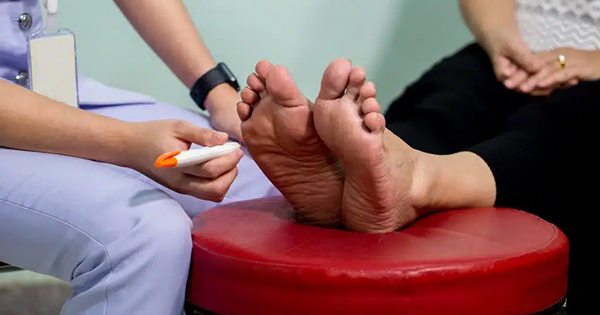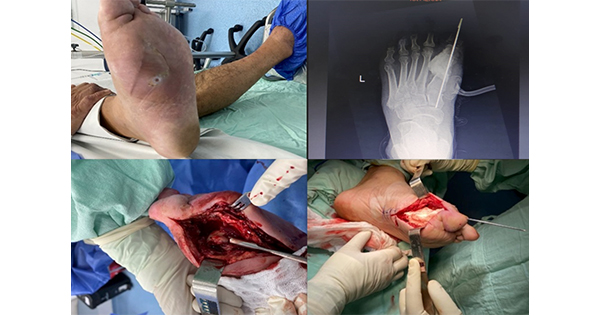Foot ulcers are common in diabetes and are associated with high morbidity, mortality and lower-extremity amputations (Foley, 1999; Baker and Osman, 2017; Jarl, 2019). Mechanical trauma is one of the key factors leading to ulceration (Raspovic and Landorf, 2014). Peripheral neuropathy ischemia and foot deformity are underlying factors that contribute to foot ulceration (Nubé et al, 2006).
Offloading is one of the primary therapies in management of diabetic foot ulcers (Raspovic and Landorf, 2014). There are various methods, including the use of devices, such as healing sandals, removable cast walkers, felted foam and total contact casts (Nubé et al, 2006; Hanft et al, 2011; Raspovic and Landorf, 2014).
Felted foam padding is a commonly used offloading modality in Western countries (Nubé et al, 2006; Ahmed, 2009; Al Thebati et al, 2016). The technique involves fixing felted foam to the plantar surface of the foot, with an aperture cut into the material corresponding to the ulcer site (Nubé et al, 2006; Ahmed, 2009; Curran et al, 2015).
Amit Jain’s offloading system is a new alternative to felted foam, with better material properties, and it works in a similar manner to felt (Jain, 2017; Jain et al, 2017). There are two types of offloading material. In Amit Jain’s standard offloading system, a combination of microcellular rubber with a viscoelastic material, such as ethyl vinyl acetate, is used; in the variant type, the viscoelastic materials are used either in isolation or in combination with materials other than microcellular rubber and ethylvinyl acetate (Jain, 2017).
This pilot study aims to compare the effectiveness of a variant offloading using a 10 mm thick, isolated ethyl vinyl acetate (a readily available viscoelastic material) to standard offloading (8 mm thickness) in the healing of plantar neuropathic ulcers.
Materials and methods
A prospective study was conducted. We recruited patients from two centres – Amit Jain’s Institute of Diabetic Foot and Wound Care, Brindhavvan Areion Hospital, and Department of Surgery, Rajarajeswari Medical College, Bengaluru. The institutional ethics committee clearance was obtained for this study (RRMCH –IEC/05/2017-2018).
The study period was from June 2018 to May 2019. Patients were randomised into two groups, with alternate patients were recruited into both the groups such that all the odd number of patients received standard offloading (group A, n=8) and even number of patients received variant offloading (group B, n=9).
Inclusion criteria
n All patients were with neuropathic non-infected ulcers on the plantar aspect of the diabetic foot of ≤5 cm were included in the study.
Exclusion criteria
- Ischaemic and neuroischaemic diabetic foot ulcers
- Patients who withdrew from study
- Patients with chronic kidney disease or liver disease
- Patients with multiple ulcers.
The offloading was applied after the standard wound care and application of sterile gauze dressing on the ulcer. The standard offloading system is 8 mm thick and is a combination of 3 mm of microcellular rubber (15 shore A) and 5 mm of ethyl vinyl acetate (Figure 1). The variant offloading consists of 10 mm of ethyl vinyl acetate (Figure 2).
An aperture was created in both offloading systems to accommodate the ulcer area (deflective offloading), similar to the concept of using felted foam. Multiple small pieces of adhesive Dynaplast plaster (Johnson & Johnson) were applied to the offloading so that it would adhere to the skin and remain static. Large Dynaplast pieces were used to firmly secure the offloading system in place. The dressings were changed every 3–4 days in the outpatient clinic and new offloading was applied until the ulcer healed. Patients were allowed to walk in their therapeutic footwear only for their routine work and needs.
Data analysis
Data was analysed using statistical software SPSS 22.0 and R environment 3.2.2 (Rosner, 2000; Riffenburg, 2005; Rao and Richard, 2006). Microsoft Word and Excel were used to generate graphs and tables. Both descriptive and inferential statistics were carried out in the study. Results on continuous measurements were presented as mean ± SD (min–max) and results of categorical measurements were presented as number (%). Significance was assessed at 5% level of significance.
The following assumptions on data were made:
- Dependent variables should be normally distributed
- Samples drawn from the population should be random
- Cases of the samples should be independent.
Student t test (two tailed, independent) was used to find the significance of study parameters on continuous scale between two groups (inter group analysis) on metric parameters. Leven’s test for homogeneity of variance was performed to assess the homogeneity of variance. Chi-squared/Fisher’s exact test was used to find the significance of study parameters on a categorical scale between two or more groups. A non-parametric setting was used for qualitative data analysis. Fisher’s exact test was used when samples were very small.
Significant figures were: suggestive significance (P value: 0.05<0.10), moderately significant (P value: 0.01<0.05) and strongly significant (P value: P≤0.01).
Results
A total of 17 patients were included in the study with eight patients in Amit Jain’s standard offloading group (group A) and nine patients in Amit Jain’s variant offloading group (group B).
There were seven men (41.2%) and 10 women (58.8%) with no difference in both groups (Figure 3). The total average age was 56.12 ± 8.48 years with no significant difference between the groups (Table 1). The majority of the patients had diabetes of 10–20 years’ duration (58.8%), with an average of 13.41 ± 9.34 years (Table 2), while 23.5% of patients had undergone a previous amputation (Table 3).
Around 76.5% of patients had forefoot ulcers, 5.9% had midfoot ulcers and 17.6% had hindfoot ulcers (Figure 4); this distribution was comparable in both groups (Table 4).
All the patients in group B (100%) had an initial wound size of <3 cm (Table 5), whereas in group A only 25% of patients had ulcers <3 cm and 75% had 3–5 cm ulcers (p=0.002, significant). The average ulcer diameter in group A was 3.94 ± 1.37 cm and in group B 1.89 ± 0.86 cm (p=0.002).
At the end of 8 weeks, almost 94.1% of all the wounds had epithelialised (Table 6), with 87.5% of wounds being healed in group A and 100% of wounds being healed in group B (p=0.471, not significant).
The overall average healing time was 35.41 ± 9.00 days. The average healing time in standard group A was 37.63 ± 7.95 days and in variant group B 33.44 ± 9.8 days (p=0.358, not significant; Figure 5)
There was no relation of age, region of foot or past amputation with ulcer diameter, although a significant association was seen with sex. The majority of men had ulcers <3 cm, whereas most women had ulcers >3 cm (Table 7).
Discussion
Many offloading modalities are available, with each having their own merits (Fitzgerald, 2009). The choice of offloading device is often governed by availability, cost, clinican skills, the individal patient’s condition and acceptability.
Felted foam is a commonly used offloading device (Al Thebati et al, 2016; Curran et al, 2015). A study by Raspovic et al (2014) showed felt to be used by 94% of clinicians for offloading. Felted foam has several benefits – it is easy to apply, has effective pressure distribution, allows for frequent wound inspection, can be used in infected cases and patients can be ambulatory (Zimny et al, 2002; Nubé et al, 2006; Curran et al, 2015; Jain, 2017). Furthermore, no iatrogenic ulceration has been reported from felt (Nubé et al, 2006).
Many authors have shown promising results with felted foam (Zimny et al, 2002; Nubé et al, 2006; Curran et al, 2015). One study showed 93% healing at 12 weeks with felted foam, compared to 92% in total contact casting (McGuire, 2010). Various studies have shown felted foam of 7–8mm thickness to be effective (Curran et al, 2015; Jain, 2018).
Total contact casting is considered by many to be the gold standard for offloading neuropathic ulcer because it reduces plantar pressure effectively (Fitzgerald, 2009). There are studies showing that total contact casting heals wounds in 90% of patients by 12 weeks (McGuire, 2010). However, there are studies showing total contact casting use to be less than 2%, even in developed countries (Wu, 2015). Issues with total contact casting include cost, time-consuming, clinician skills, patient adherence and iatrogenic ulcers; it is also contraindicated in infection and ischaemia (Sambrook et al, 2015; Jain, 2017; Singh et al, 2017).
Felted foam is unavailable in many places. It loses its pressure-relieving properties within 3 days, after which it is ineffective (Zimny et al, 2001).
Amit Jain’s offloading technique was developed to address these issues. It can be considered as a good alternative to felted foam, due to better material properties (Jain, 2017; 2018). It has many of the advantages of felted foam (Box 1).
In an earlier series, Amit Jain’s offloading system showed 89% of cases healed in different types of plantar wounds within 16 weeks of application with 96% of patients receiving standard combination (Jain et al, 2017).
The current prospective randomised study was conducted to assess whether a variant type of Amit Jain’s offloading system is as effective as standard offloading in clinical practice. Uncomplicated plantar neuropathic ulcers should heal within 8 weeks of offloading, although they can take slightly longer in certain scenarios (Cavanagh and Bus, 2010; Jain 2018).
This pilot study showed that 94% of neuropathic plantar ulcers healed by end of 8 weeks and all wounds healed by 12 weeks, with no differences in either group. At end of 8 weeks, healing in the variant offloading group was comparable to the standard offloading group.
There are a few limitations in our study. Being a pilot study, the sample size was small. Furthermore, the thickness used in both types of offloading was unequal due to non-availability of 8 mm ethyl vinyl acetate. Ethyl vinyl acetate is only available as 2 mm, 5 mm or 10 mm.
Amit Jain’s offloading system is a new, simple, synthetic, therapeutic offloading system that can be used as an alternative to felted foam and in situations and places where total contact casting cannot be used. It is currently best at reducing high peak pressure in patients with neuropathic plantar ulcers (Jain, 2017b; Jain et al, 2017; Boghossian et al, 2017). This new offloading is easy to prepare using viscoelastic materials.
Conclusion
Offloading is an important treatment modality for healing plantar ulcers. This pilot study showed that both types of Amit Jain’s offloading system significantly healed the ulcers in spite of differences in thickness. Almost 94% of the ulcers healed at the end of 8 weeks, with no significant difference between both the groups, and the overall average healing being 35.41 ± 9.00 days. However, it was noted that the ulcer diameter was significantly larger in the standard offloading group, yet this group had comparable healing at 8 weeks with the variant offloading group, in whom the average ulcer diameter was significantly smaller.
Amit Jain’s offloading system is a new offloading system with promising results. It can be considered as an alternative to felted foam in developing and underdeveloped countries in view of its healing time, cost, ease of application and material properties. Further studies will be needed to see the efficacy of variant types of this system.




